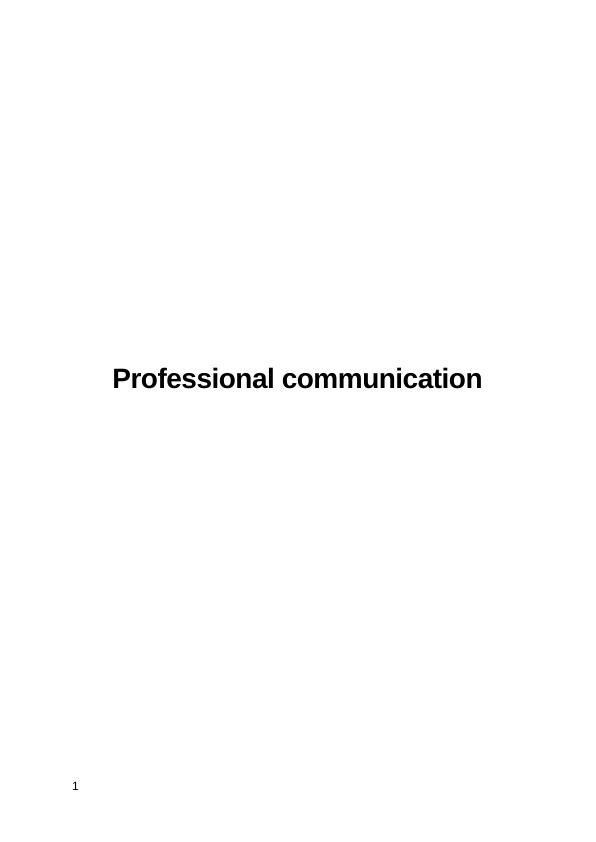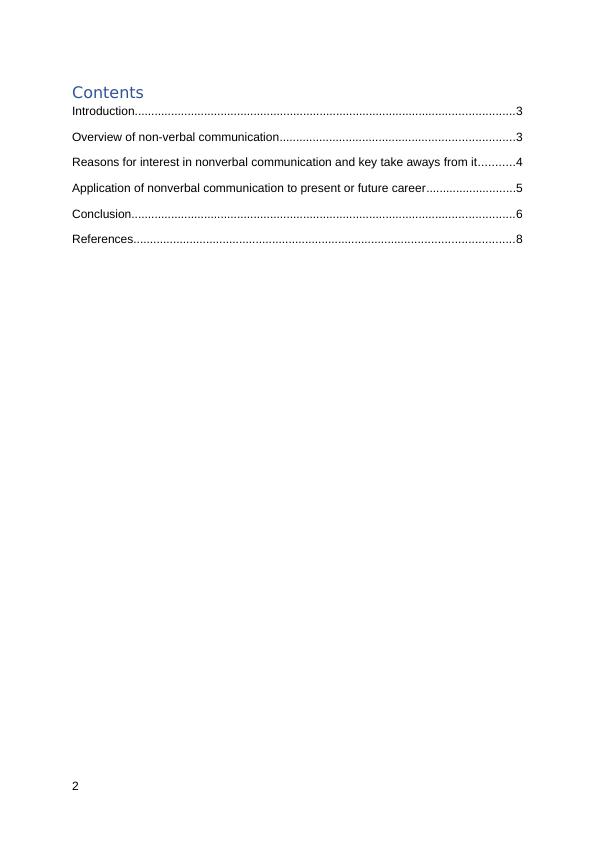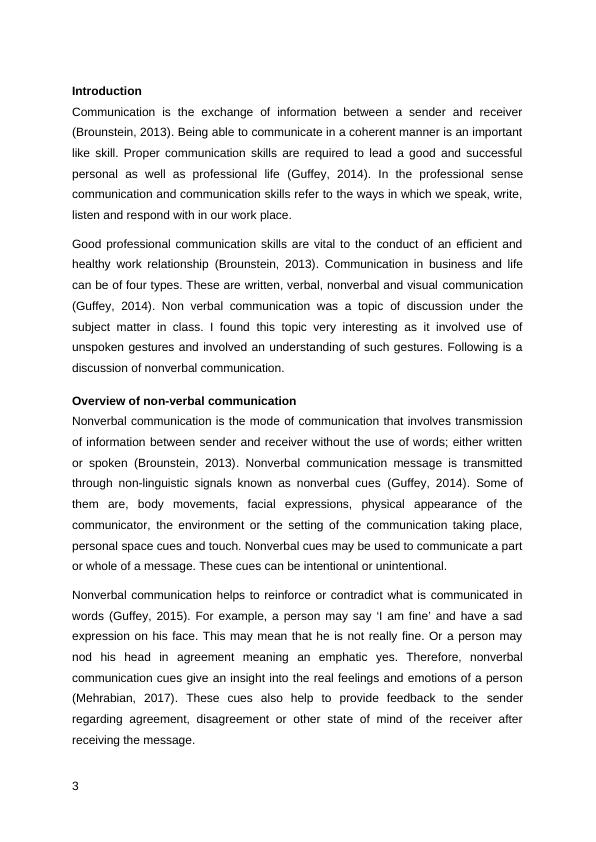Nonverbal Communication in Professional Settings
Added on 2022-10-15
8 Pages2042 Words80 Views
Professional communication
1
1

Contents
Introduction...................................................................................................................3
Overview of non-verbal communication.......................................................................3
Reasons for interest in nonverbal communication and key take aways from it...........4
Application of nonverbal communication to present or future career...........................5
Conclusion....................................................................................................................6
References...................................................................................................................8
2
Introduction...................................................................................................................3
Overview of non-verbal communication.......................................................................3
Reasons for interest in nonverbal communication and key take aways from it...........4
Application of nonverbal communication to present or future career...........................5
Conclusion....................................................................................................................6
References...................................................................................................................8
2

Introduction
Communication is the exchange of information between a sender and receiver
(Brounstein, 2013). Being able to communicate in a coherent manner is an important
like skill. Proper communication skills are required to lead a good and successful
personal as well as professional life (Guffey, 2014). In the professional sense
communication and communication skills refer to the ways in which we speak, write,
listen and respond with in our work place.
Good professional communication skills are vital to the conduct of an efficient and
healthy work relationship (Brounstein, 2013). Communication in business and life
can be of four types. These are written, verbal, nonverbal and visual communication
(Guffey, 2014). Non verbal communication was a topic of discussion under the
subject matter in class. I found this topic very interesting as it involved use of
unspoken gestures and involved an understanding of such gestures. Following is a
discussion of nonverbal communication.
Overview of non-verbal communication
Nonverbal communication is the mode of communication that involves transmission
of information between sender and receiver without the use of words; either written
or spoken (Brounstein, 2013). Nonverbal communication message is transmitted
through non-linguistic signals known as nonverbal cues (Guffey, 2014). Some of
them are, body movements, facial expressions, physical appearance of the
communicator, the environment or the setting of the communication taking place,
personal space cues and touch. Nonverbal cues may be used to communicate a part
or whole of a message. These cues can be intentional or unintentional.
Nonverbal communication helps to reinforce or contradict what is communicated in
words (Guffey, 2015). For example, a person may say ‘I am fine’ and have a sad
expression on his face. This may mean that he is not really fine. Or a person may
nod his head in agreement meaning an emphatic yes. Therefore, nonverbal
communication cues give an insight into the real feelings and emotions of a person
(Mehrabian, 2017). These cues also help to provide feedback to the sender
regarding agreement, disagreement or other state of mind of the receiver after
receiving the message.
3
Communication is the exchange of information between a sender and receiver
(Brounstein, 2013). Being able to communicate in a coherent manner is an important
like skill. Proper communication skills are required to lead a good and successful
personal as well as professional life (Guffey, 2014). In the professional sense
communication and communication skills refer to the ways in which we speak, write,
listen and respond with in our work place.
Good professional communication skills are vital to the conduct of an efficient and
healthy work relationship (Brounstein, 2013). Communication in business and life
can be of four types. These are written, verbal, nonverbal and visual communication
(Guffey, 2014). Non verbal communication was a topic of discussion under the
subject matter in class. I found this topic very interesting as it involved use of
unspoken gestures and involved an understanding of such gestures. Following is a
discussion of nonverbal communication.
Overview of non-verbal communication
Nonverbal communication is the mode of communication that involves transmission
of information between sender and receiver without the use of words; either written
or spoken (Brounstein, 2013). Nonverbal communication message is transmitted
through non-linguistic signals known as nonverbal cues (Guffey, 2014). Some of
them are, body movements, facial expressions, physical appearance of the
communicator, the environment or the setting of the communication taking place,
personal space cues and touch. Nonverbal cues may be used to communicate a part
or whole of a message. These cues can be intentional or unintentional.
Nonverbal communication helps to reinforce or contradict what is communicated in
words (Guffey, 2015). For example, a person may say ‘I am fine’ and have a sad
expression on his face. This may mean that he is not really fine. Or a person may
nod his head in agreement meaning an emphatic yes. Therefore, nonverbal
communication cues give an insight into the real feelings and emotions of a person
(Mehrabian, 2017). These cues also help to provide feedback to the sender
regarding agreement, disagreement or other state of mind of the receiver after
receiving the message.
3

End of preview
Want to access all the pages? Upload your documents or become a member.
Related Documents
Non-verbal Communicationlg...
|8
|1529
|22
Relational Communication: Importance of Non-Verbal Communicationlg...
|13
|3698
|73
Analysis of Non-Verbal Communicationlg...
|6
|504
|346
Non-Verbal Communicationlg...
|7
|1465
|478
Non Verbal Communicationlg...
|7
|1382
|227
Analysis of Non-Verbal Communicationlg...
|7
|1591
|135
